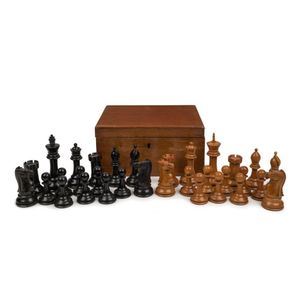19th Century Staunton Chess Set in Boxwood and Ebony
Staunton antique English chess set in boxwood and ebony, housed in a mahogany box with green felt lining, 19th century, bearing crown mark, the King pieces 11.3 cm high
You must be a subscriber, and be logged in to view price and dealer details.
Subscribe Now to view actual auction price for this item
When you subscribe, you have the option of setting the currency in which to display prices to $Au, $US, $NZ or Stg.
This item has been sold, and the description, image and price are for reference purposes only.
- Mahogany - Mahogany is a dense, close grained red-coloured timber from the West Indies and Central America. It was first imported into Europe in the the early 18th century and its use continued through the 19th century. It was popular for furniture making because of its strength, the wide boards available, the distinctive grain on some boards, termed flame mahogany and the rich warm colour of the timber when it was polished.. The "flame" was produced where a limb grew out from the trunk of the tree, and this timber was usually sliced into veneers for feature panels on doors, backs and cornices.
Some terms used to describe mahogany relate to the country from which it originally came, such as "Cuban" mahogany, "Honduras" mahogany etc. However unless the wood has been tested the names assigned are more a selling feature, rather than a true indication of the timber's origin. - Ebony - Ebony is a close grained timber, black in colour. It has a fine texture which can be polished to a high gloss, making it suitable for venereering, inlay and stringing and its use as solid timber is resticted to small decorative items and ornamental decoration, such as chess pieces and musical instrument parts. The term "ebonised" means "faux ebony", timber that has been darkened during the polishing process to resemble ebony.
- Boxwood - Boxwood is a hard, yellow coloured, close grained timber. In the 19th century it was often used for inlays, especially stringing, because of its contrasting colour to the darker timbers of the carcase. Stringing is the inlay of a narrow strip of veneer of a lighter colour, such as boxwood along or close to the edges of an object that has been veneered in a darker timber such as mahogany.
Because of its fine grain and resistnce to splitting or chipping it has also been used for treen, turnings, carvings and other small wooden items, such as chess pieces. - Staunton Chess Set - How should the king, queen, rooks and other pieces be depicted? Why is the king always the tallest piece and have a cross on his head. And why is the knight depicted as a horse head?
Until the adaption of a standard design, the designs of the pieces in every set varied. The Staunton chess set set a standard design for each piece used in the game of chess, and was the style adopted for use in chess competitions.
The Staunton designs were developed in 1849 and sold by sports and games manufacturers Jaques & Son of London, and were either designed by the proprietor of the firm, John Jaques or his his brother in law, Nathaniel Cook.
The design was named after Howard Staunton, an English chess player who was regarded as the leading player in the 1840s to 1850s.
The style has been popular for more than 160 years, and is still the standard today in tournament chess games and competitions.
This item has been included into following indexes:
